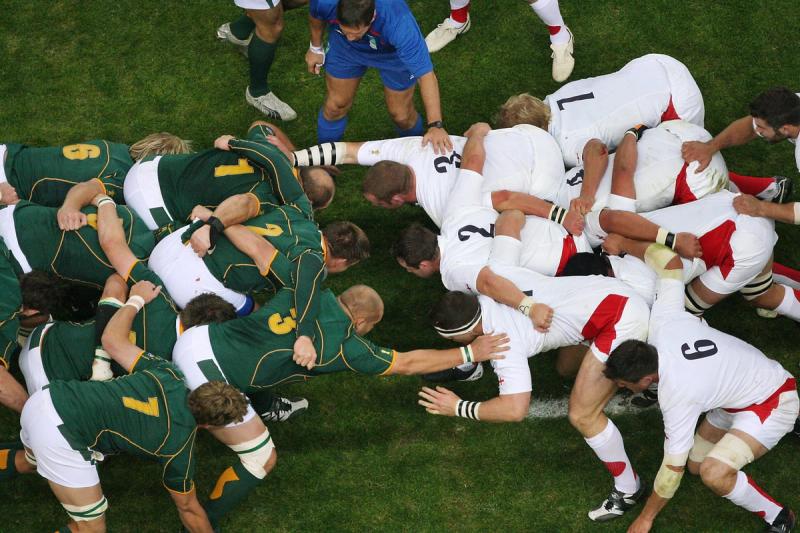Rugby is a sport that has undergone significant evolution over its long and storied history. From its humble beginnings on the fields of England in the 19th century to its status as a global phenomenon today, rugby has continually evolved, adapting to changes in the game, advancements in technology, and shifts in playing styles.
Central to this evolution has been the development of tactics – the strategic plans and techniques employed by teams to gain an advantage over their opponents. Throughout the years, rugby tactics have undergone numerous transformations, driven by innovations in coaching, player fitness, and game analysis.
In this article, we'll explore the top 5 innovations that have changed the game of rugby, revolutionizing the way teams approach and play the sport. From the introduction of set plays to the adoption of modern defensive structures, these innovations have reshaped the landscape of rugby and influenced the way the game is played at all levels.

The Introduction of Set Plays:
One of the most significant innovations in the history of rugby tactics has been the introduction of set plays, which involve pre-planned strategies executed from set-piece situations such as scrums, lineouts, and restarts. Set plays allow teams to capitalize on specific situations and create scoring opportunities through precision and coordination.
One of the earliest set plays to gain prominence in rugby was the lineout, which was first introduced in the late 19th century. Originally a means of restarting play after the ball went out of bounds, the lineout quickly evolved into a strategic weapon, with teams developing intricate moves and formations to win possession and launch attacking plays.
Similarly, the scrum has long been a focal point of rugby tactics, serving as a platform for teams to assert their dominance and control possession. Over the years, teams have developed specialized scrum techniques and formations aimed at gaining a competitive advantage and disrupting their opponents' set-piece plays.
The introduction of set plays revolutionized the way teams approached the game, elevating rugby tactics to a new level of sophistication and strategic complexity. Today, set plays remain a fundamental aspect of rugby strategy, with teams investing significant time and resources into perfecting their execution and maximizing their effectiveness on the field.
The Emergence of Total Rugby:
In the 1970s, a revolutionary style of play known as "Total Rugby" emerged, challenging traditional notions of positional specialization and tactical rigidity. Coined by New Zealand coach Fred Allen, Total Rugby emphasized fluidity, creativity, and adaptability, encouraging players to express themselves freely and play with spontaneity and flair.
At the heart of Total Rugby was the concept of "unstructured play," which encouraged players to read and react to the unfolding dynamics of the game, rather than adhering to predetermined patterns and structures. This emphasis on improvisation and intuition gave rise to a more dynamic and unpredictable style of rugby, characterized by quick ball movement, offloading in contact, and support play.
Total Rugby represented a departure from the rigid positional roles and structured game plans that had previously defined the sport, challenging players to think creatively and make split-second decisions based on the flow of the game. While it was initially met with skepticism and resistance, Total Rugby ultimately revolutionized the way the game was played, inspiring generations of players and coaches to embrace a more expansive and inclusive style of rugby.
The Rise of Defensive Structures:
As the game of rugby became increasingly dynamic and expansive, teams began to place greater emphasis on defense, recognizing its crucial role in nullifying the attacking threats posed by their opponents. This shift in focus led to the development of modern defensive structures and systems aimed at denying space, pressuring ball carriers, and forcing turnovers.
One of the most influential defensive innovations in rugby has been the development of the "rush defense," which involves aggressive line speed and coordinated tackling to disrupt the attacking team's rhythm and prevent them from gaining momentum. By closing down space and putting pressure on the ball carrier, the rush defense has become a potent weapon in the modern game, allowing teams to dictate the terms of engagement and dictate the flow of play.
Another key defensive innovation has been the advent of "chop tackling," a technique that emphasizes low, effective tackles aimed at stopping the ball carrier's forward momentum and preventing offloads in contact. Chop tackling has become a cornerstone of modern defensive strategy, enabling teams to regain possession quickly and launch counter-attacks from turnovers.
In addition to individual techniques, teams have also developed sophisticated defensive structures and patterns designed to counter specific attacking threats and exploit weaknesses in the opposition's game plan. From the "umbrella defense" to the "blitz defense," these tactical innovations have reshaped the way teams approach defense, emphasizing teamwork, communication, and discipline.
The Evolution of Set Piece Plays:
In recent years, there has been a renewed focus on the set piece as a platform for generating attacking opportunities and creating scoring chances. With scrums and lineouts becoming increasingly competitive and strategic, teams have invested significant time and resources into developing specialized set piece plays aimed at exploiting weaknesses in the opposition's defense.
In the scrum, teams have experimented with innovative techniques and formations designed to gain a decisive advantage over their opponents. From the use of "scrum shifts" to manipulate the angle of engagement to the deployment of "sneaky plays" to catch the defense off guard, scrum tactics have become increasingly sophisticated and nuanced, reflecting the importance of set piece dominance in modern rugby.
Similarly, lineout plays have evolved to become more dynamic and unpredictable, with teams employing a variety of tactics and movements to outmaneuver the opposition and create space for their attacking players. From intricate lineout mauls to deceptive dummy plays, lineout tactics have become a key weapon in the arsenal of modern rugby teams, allowing them to control possession and dictate the tempo of the game.
The evolution of set piece plays has reshaped the way teams approach the game, emphasizing creativity, innovation, and adaptability in both attack and defense. As teams continue to push the boundaries of tactical ingenuity, the set piece remains a crucial battleground where matches can be won or lost.
The Impact of Data Analytics:
In recent years, the advent of data analytics has revolutionized the way rugby teams prepare for matches, analyze performance, and make tactical decisions on the field. Through the use of advanced statistical models, video analysis software, and wearable technology, teams are able to gather vast amounts of data on every aspect of the game, from player movements and ball possession to set piece success rates and defensive patterns.
By analyzing this data, coaches and analysts are able to identify trends, patterns, and areas for improvement, allowing them to tailor their game plans and strategies to exploit the weaknesses of their opponents. From identifying vulnerabilities in the opposition's defense to optimizing player positioning and movement patterns, data analytics has become an indispensable tool in the modern rugby coach's arsenal.
One of the most significant applications of data analytics in rugby has been the development of "game intelligence" systems, which use artificial intelligence and machine learning algorithms to analyze vast quantities of data in real-time and provide coaches and players with actionable insights and recommendations during matches. By providing instant feedback and tactical guidance, these systems enable teams to make informed decisions and adapt their strategies on the fly, giving them a competitive edge on the field.
In addition to its impact on in-game decision-making, data analytics has also revolutionized the way teams train and prepare for matches, allowing coaches to monitor player performance, track fitness levels, and identify areas for improvement with unprecedented accuracy and precision. From optimizing training loads and recovery protocols to fine-tuning individual skills and techniques, data analytics has become an essential component of modern rugby coaching and player development.
Conclusion:
The evolution of rugby tactics is a testament to the sport's ability to adapt and innovate in response to changing trends, technologies, and playing styles. From the introduction of set plays to the rise of defensive structures, the game of rugby has continually evolved, driven by a relentless pursuit of excellence and a commitment to pushing the boundaries of what is possible on the field.
As we look to the future, the evolution of rugby tactics shows no signs of slowing down, with teams and coaches continuing to explore new strategies, techniques, and technologies to gain a competitive edge. Whether it's through the development of innovative set piece plays, the refinement of defensive structures, or the integration of data analytics into every aspect of the game, the quest for tactical mastery remains at the heart of rugby's enduring appeal.
In the end, it is the relentless pursuit of innovation and excellence that defines the evolution of rugby tactics, shaping the way the game is played and experienced by players and fans alike. As the sport continues to evolve and adapt to new challenges and opportunities, one thing remains certain: the spirit of innovation and creativity that drives rugby forward will continue to inspire and captivate audiences around the world for generations to come.
Related posts
See all
February 23rd
The Evolution of Rugby Tactics: Top 5 Innovations That Changed the Game
Discover the dynamic evolution of rugby tactics through the top 5 innovations that reshaped the game. From the introduction of set plays to the embrace of data analytics, rugby's strategic landscape has evolved dramatically. These innovations reflect a relentless pursuit of excellence and a commitm...

February 20th
Total Rugby: Embracing the Essence of Dynamic Play
Total Rugby, born from Fred Allen's vision, revolutionized rugby with its fluidity and creativity. Encouraging unstructured play, it empowered players to adapt and express themselves freely on the field. Its legacy extends globally, inspiring teams to embrace versatility and innovation. Total Rugby ...

January 4th
Triple Crown Triumph: Rugby's Prestigious Trophy
The Triple Crown, steeped in rugby lore, transcends sport as a symbol of excellence and national pride. From its origins in the late 19th century to the modern era's dynamic clashes.

November 19th
Evolution of Rugby: From Inception to Modern-day Mastery
Unveil the evolution, triumphs, and challenges that define rugby's unparalleled journey—a testament to the enduring spirit that has shaped it into a worldwide phenomenon.

November 9th
Scrums and Lineouts Demystified: Rugby Basics
Rugby's scrums and lineouts, often seen as intricate components, are pivotal in the sport's dynamics.

November 6th
Rugby Basics: A Step-by-Step Guide to Scoring a Try
Scoring a try in rugby is a thrilling culmination of teamwork, strategy, and skill. It involves grounding the ball with downward pressure in the opponent's in-goal area, worth five points.